Thai Beverage Bundle
How Does Thai Beverage Company Capture Its Customers?
Thai Beverage Company's (ThaiBev) success hinges on a deep understanding of its customer base. From its origins in alcoholic beverages like Chang beer to its expansive portfolio including non-alcoholic drinks and food, ThaiBev has strategically adapted. This evolution underscores the critical need to analyze its Thai Beverage SWOT Analysis, understand its customer demographics, and identify its target market.
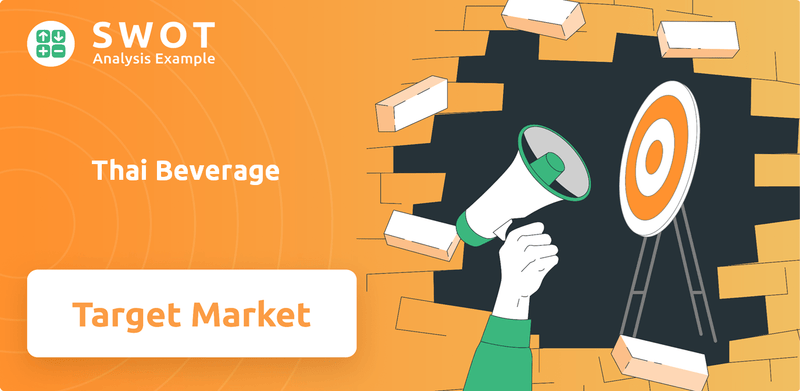
This exploration delves into the consumer profile, market segmentation, and the beverage industry dynamics that shape ThaiBev's strategies. We'll examine who the main consumers of Chang beer are, what age group drinks Thai whiskey, and the demographic breakdown of Thai beer drinkers. Furthermore, we'll analyze the target market analysis for Oishi green tea and how ThaiBev navigates market trends and opportunities to maintain its leadership in the ASEAN region. Understanding Thai Beverage Company's customer demographics and target market is key to its continued growth.
Who Are Thai Beverage’s Main Customers?
Understanding the customer demographics and target market of the Thai Beverage Company (ThaiBev) is crucial for grasping its market position. ThaiBev primarily operates in the Business-to-Consumer (B2C) sector, serving a diverse customer base across its alcoholic beverages, non-alcoholic beverages, and food segments. While specific demographic breakdowns are proprietary, general market trends and ThaiBev's product portfolio offer insights into its key target groups.
The company's strategy involves a multi-segment approach, catering to a wide range of consumers. This includes adults of legal drinking age for alcoholic beverages and a broader demographic encompassing all age groups and income levels for non-alcoholic beverages. Additionally, the food business targets families, young adults, and urban populations. This diversified approach allows ThaiBev to capture a larger market share and adapt to evolving consumer preferences.
The company's focus on innovation and health-related products, such as the planned introduction of 'F&N Nutriwell' health products in 2025, indicates a strategic shift towards health-conscious consumers. This diversification, along with expansion plans for its food segment, reflects ThaiBev's commitment to adapting to changing consumer demands and market trends. The company's ability to understand and cater to different consumer profiles is key to its continued success in the beverage industry.
The primary customers for alcoholic beverages, especially beer and spirits, are adults of legal drinking age. The beer division saw a 2.6% increase in sales volume in Q2 FY2025 and a 7.4% increase in total sales volume in the first half of FY2025. The spirits segment experienced a 2.1% rise in sales revenue in Q2 FY2025, despite challenges.
This segment targets a broad demographic, including all age groups and income levels. Sales revenue rose by 7.2% year-on-year in Q1 FY2025, with total sales volume increasing by 7.5% in Q1 FY2025. This includes ready-to-drink tea, coffee, energy drinks, and fruit-flavored beverages.
The food business, primarily through KFC and Oishi restaurants, caters to families, young adults, and urban populations. Revenue increased by 2.2% year-on-year in Q1 FY2025. ThaiBev plans to open 69 new restaurant outlets in 2025 under its KFC and Oishi brands.
ThaiBev is diversifying its product portfolio, with a stronger emphasis on non-alcoholic beverages and food. This shift aligns with evolving consumer trends towards healthier options and convenient food services. Market research and external trends, such as the rebound in tourism, positively impact consumer sentiment.
ThaiBev's market segmentation strategy focuses on distinct consumer groups within its three main segments: alcoholic beverages, non-alcoholic beverages, and food. The company uses different marketing strategies and product offerings to cater to each segment effectively, maximizing its reach and market penetration. The company's ability to understand and cater to different consumer profiles is key to its continued success in the beverage industry.
- Adults of legal drinking age are the primary consumers of alcoholic beverages, particularly beer and spirits.
- All age groups and income levels are targeted by the non-alcoholic beverage segment, including health-conscious consumers.
- Families, young adults, and urban populations are the main consumers of the food business, particularly KFC and Oishi restaurants.
- ThaiBev is expanding its reach by diversifying its product portfolio, including health-related products and convenient food services.
Thai Beverage SWOT Analysis
- Complete SWOT Breakdown
- Fully Customizable
- Editable in Excel & Word
- Professional Formatting
- Investor-Ready Format
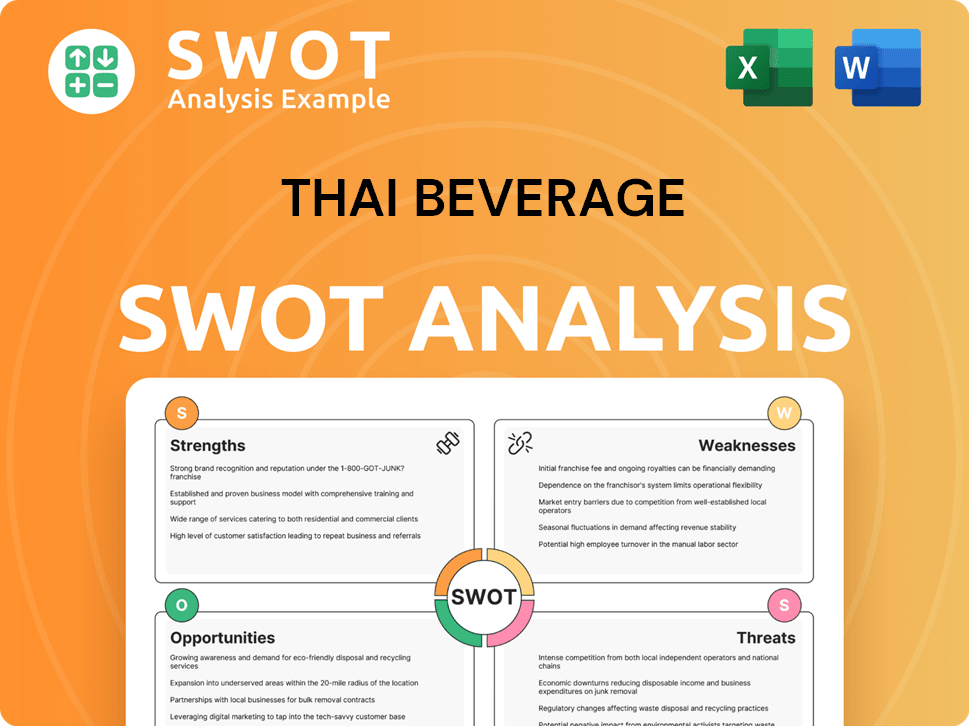
What Do Thai Beverage’s Customers Want?
Understanding the customer needs and preferences is crucial for the success of the Thai Beverage Company. The company's approach involves tailoring its product development and marketing strategies to align with the diverse needs of its consumers. This includes addressing both practical and aspirational desires across its various segments, from alcoholic and non-alcoholic beverages to food offerings.
The company focuses on market segmentation to cater to different consumer profiles. This involves analyzing consumer behavior, understanding demographic breakdowns, and identifying key trends within the beverage industry. By doing so, ThaiBev aims to maintain and grow its market share in Thailand and beyond.
The company's commitment to customer satisfaction and brand loyalty is evident in its efforts to adapt to changing consumer behavior and provide innovative solutions. This approach enables ThaiBev to effectively reach its target audience and implement successful marketing strategies.
Consumers of alcoholic beverages often seek products for social occasions, relaxation, and cultural experiences. The demand for beer is influenced by factors like tourism and weather. The company is expanding its beer portfolio to cater to consumers looking for higher quality options.
ThaiBev's beer business saw a 2.4% increase in sales revenue in FY2024. This growth reflects the company's ability to capitalize on market trends and consumer demand. The introduction of products like Chang Cold Brew aims to capture a broader consumer base.
The spirits segment has faced challenges due to higher raw material costs and increased marketing expenditures. This indicates the sensitivity of consumers to pricing and brand investment. Understanding these dynamics is crucial for strategic decision-making.
Key drivers in the non-alcoholic beverage segment include health consciousness, convenience, and variety. ThaiBev is responding to the growing demand for healthier options. The company is investing in dairy production and introducing new health products.
The non-alcoholic beverage segment showed strong performance, with a 7.2% year-on-year revenue increase in Q1 FY2025. EBITDA rose by 15.6%, indicating consumer acceptance of these offerings. Ready-to-drink formats are popular due to their convenience.
Customers in the food segment prioritize convenience, quality, and a diverse menu. ThaiBev's expansion of its KFC and Oishi restaurant brands directly addresses these needs. The company leverages customer feedback to inform product development and adapt to evolving consumer behavior.
Brand reputation, product quality, and effective marketing influence loyalty across all segments. ThaiBev's 'Passion 2030' vision focuses on optimizing product and service delivery. This vision reinforces the company's commitment to tailoring offerings and customer experiences.
- ThaiBev utilizes market trends to inform product development, ensuring it meets consumer needs.
- The company's agility in adapting to evolving consumer behavior is a key strength.
- Digital solutions are provided to enhance customer experience and satisfaction.
- The expansion of convenience store networks and platform delivery services supports on-the-go consumption.
For more in-depth insights, explore the Owners & Shareholders of Thai Beverage article.
Thai Beverage PESTLE Analysis
- Covers All 6 PESTLE Categories
- No Research Needed – Save Hours of Work
- Built by Experts, Trusted by Consultants
- Instant Download, Ready to Use
- 100% Editable, Fully Customizable
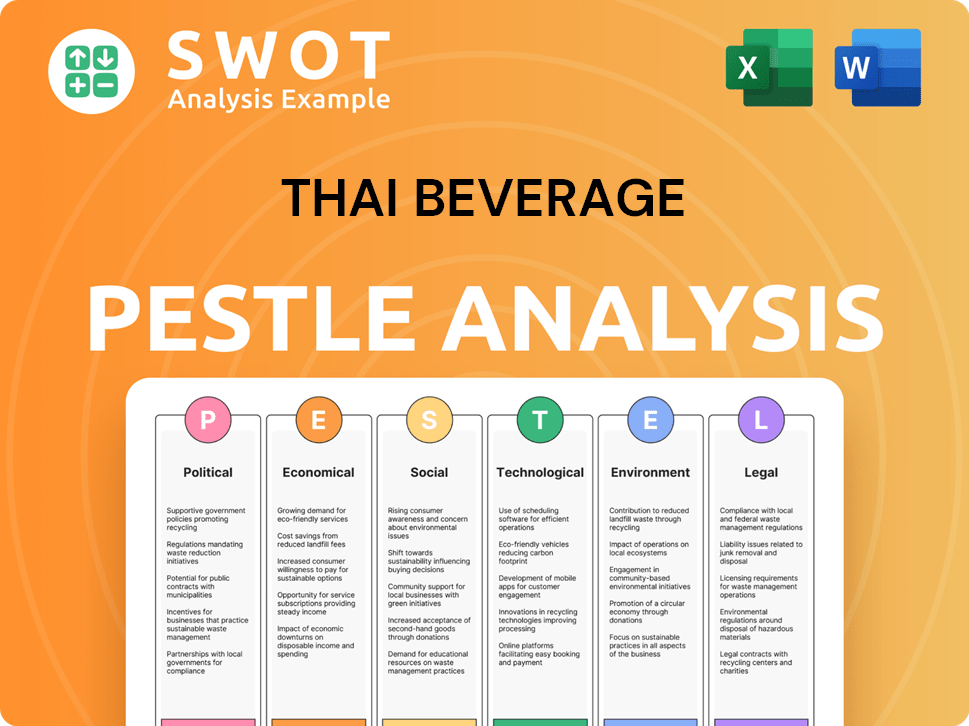
Where does Thai Beverage operate?
The geographical market presence of Thai Beverage Company is primarily concentrated in Southeast Asia, with a strong foothold in Thailand and Vietnam. Thailand serves as its home market and largest revenue generator, contributing significantly to the company's overall financial performance. Vietnam is the second-largest market, playing a crucial role in ThaiBev's regional strategy.
In fiscal year 2024, Thailand generated THB219,873 million (approximately $6.44 billion) in revenue, showcasing its dominance in the market. Vietnam followed with THB58,319 million (around $1.71 billion), despite a slight decrease compared to the previous year. This illustrates the importance of these two countries in the company's revenue stream.
Beyond its core markets, Thai Beverage Company has a presence in over 90 countries, with strategic focus on Malaysia, Myanmar, Singapore, Cambodia, Laos, and Indonesia for its non-alcoholic beverages. The company's expansion strategy involves localizing offerings and increasing its footprint in these key markets.
Thailand is the primary market for Thai Beverage Company, contributing the largest share of revenue. The company aims to maintain its market leadership in the beer segment, anticipating a recovery to pre-pandemic levels. The focus is on adapting to evolving consumer preferences and market dynamics to sustain growth.
Vietnam is the second-largest market for ThaiBev, with a significant contribution to overall revenue. The company holds a controlling stake in Sabeco, the largest beer player in Vietnam. The Vietnamese beer market shows positive growth, supported by government investments and foreign investments.
Thai Beverage Company is expanding its presence in Malaysia, Myanmar, Singapore, Cambodia, Laos, and Indonesia. The company is investing in new facilities and localizing its product offerings to cater to regional preferences. The company is investing 2.5 billion baht in Cambodia, and 8 billion baht in Malaysia.
The company adapts its strategies to local tastes and market dynamics, as seen in Cambodia with the introduction of new health products. The company is expanding its Oishi green tea and Tea Pot milk brands in Cambodia. The overall Thai beverage industry is largely focused on supplying the domestic market.
The company's focus on understanding its target market and adapting to local preferences is crucial for sustained growth. The company's strategy involves adapting to local tastes and market dynamics, as seen in its efforts to introduce new health products and expand its Oishi green tea and Tea Pot milk brands in Cambodia. The differences in customer demographics, preferences, and buying power across these regions necessitate tailored approaches.
Thai Beverage Business Model Canvas
- Complete 9-Block Business Model Canvas
- Effortlessly Communicate Your Business Strategy
- Investor-Ready BMC Format
- 100% Editable and Customizable
- Clear and Structured Layout
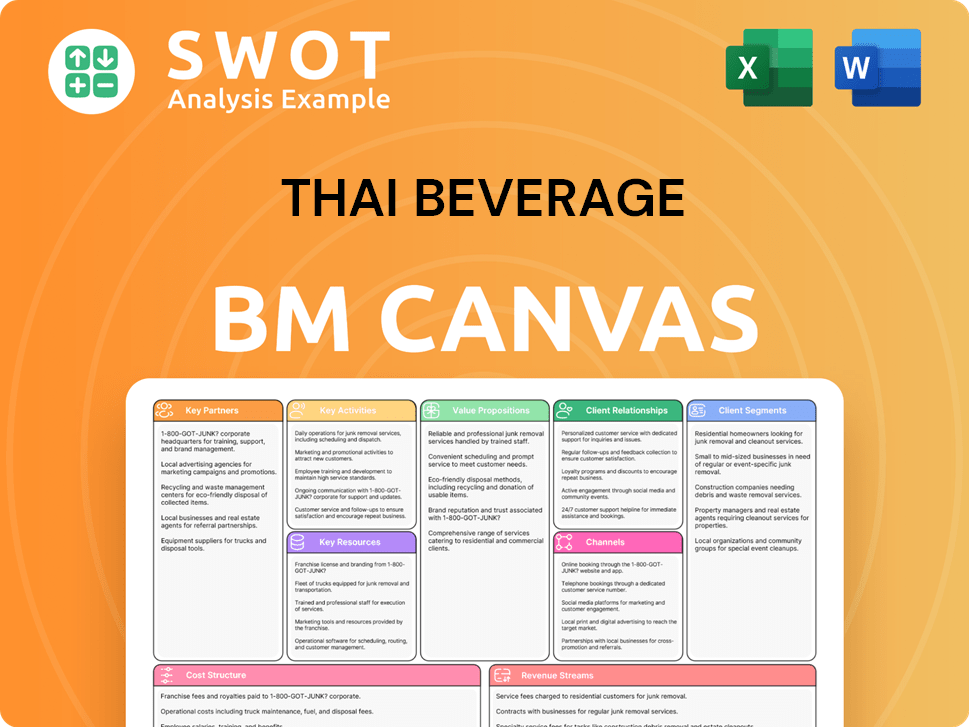
How Does Thai Beverage Win & Keep Customers?
The Thai Beverage Company (ThaiBev) employs a multi-faceted approach to customer acquisition and retention, focusing on a blend of traditional and digital marketing strategies. Its 'Passion 2030' vision emphasizes adapting to evolving consumer behavior and leveraging digital platforms for expansion. This includes optimizing product and service delivery across various channels to maximize market penetration. For instance, aggressive marketing with innovative technology is planned to position Chang as the top beer in the Thai market.
ThaiBev's customer acquisition strategy involves significant investments in new product launches and expanding its market reach. The company aims to capture new segments through product innovation and strategic market positioning. The company's expansion also includes opening new restaurant outlets, increasing brand visibility and accessibility to attract new customers.
Customer retention strategies are focused on maintaining a strong brand portfolio, ensuring product quality, and fostering loyalty. ThaiBev aims to maintain its market leader position in key segments by expanding its product portfolio. The company also focuses on sustainability to resonate with environmentally conscious consumers, potentially fostering loyalty. Moreover, the company's consistent dividend policy contributes to shareholder loyalty, which can indirectly support overall business stability and customer trust.
ThaiBev utilizes digital platforms to adapt to evolving consumer behavior. This includes optimizing product and service delivery across multiple channels. The company aggressively markets with innovative technology to position Chang as the top beer in the Thai market, showcasing its focus on digital expansion.
The launch of PRAKAAN, a premium whisky, in September 2024, is a key acquisition strategy. The expansion of Oishi green tea and Tea Pot milk brands in Cambodia in 2025 aims to capture new consumer segments. Opening 69 new restaurant outlets, primarily KFC and Oishi, in 2025 increases brand visibility.
ThaiBev focuses on maintaining its market leader position in key segments, such as the Thai beer market. Expanding its product portfolio to a 'mass premium group' with offerings like Chang Cold Brew supports this goal. The company's market share in Thailand is a key indicator of its success in this area.
ThaiBev's commitment to sustainability, targeting net-zero emissions by FY2050 and a 42% reduction in Scope 1 and 2 emissions by FY2030, fosters loyalty. This resonates with environmentally conscious consumers. These efforts also contribute to the company's brand loyalty factors.
ThaiBev's approach to customer acquisition and retention is comprehensive, combining digital marketing, product innovation, and strategic market positioning. The company’s strategies are designed to maintain and strengthen its market position. To learn more about the company's financial strategies, consider reading about Revenue Streams & Business Model of Thai Beverage.
Thai Beverage Porter's Five Forces Analysis
- Covers All 5 Competitive Forces in Detail
- Structured for Consultants, Students, and Founders
- 100% Editable in Microsoft Word & Excel
- Instant Digital Download – Use Immediately
- Compatible with Mac & PC – Fully Unlocked
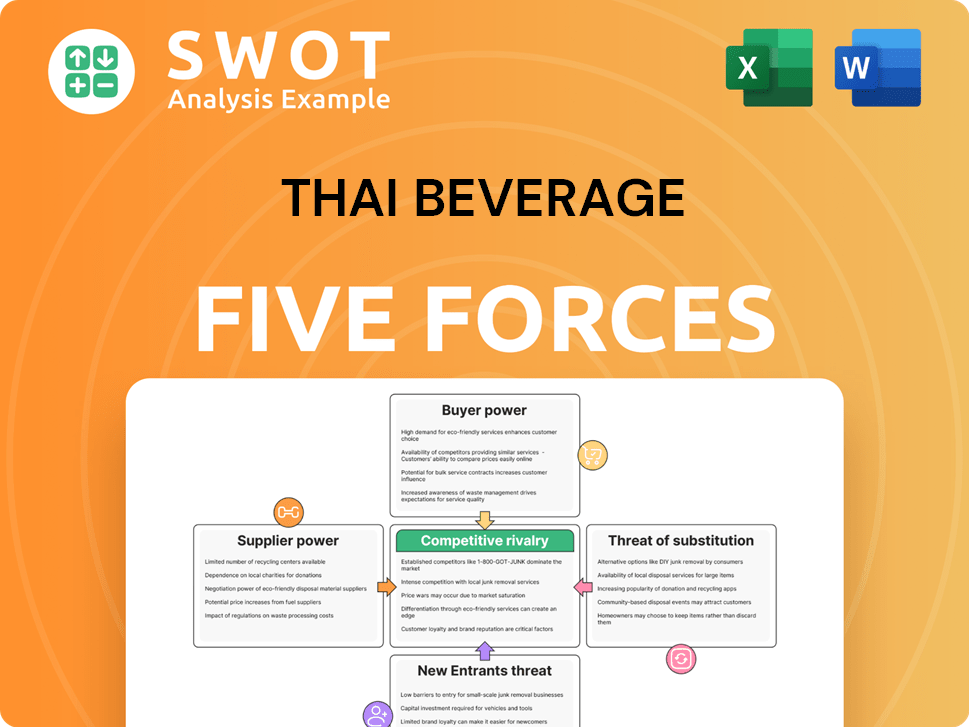
Related Blogs
- What are Mission Vision & Core Values of Thai Beverage Company?
- What is Competitive Landscape of Thai Beverage Company?
- What is Growth Strategy and Future Prospects of Thai Beverage Company?
- How Does Thai Beverage Company Work?
- What is Sales and Marketing Strategy of Thai Beverage Company?
- What is Brief History of Thai Beverage Company?
- Who Owns Thai Beverage Company?
Disclaimer
All information, articles, and product details provided on this website are for general informational and educational purposes only. We do not claim any ownership over, nor do we intend to infringe upon, any trademarks, copyrights, logos, brand names, or other intellectual property mentioned or depicted on this site. Such intellectual property remains the property of its respective owners, and any references here are made solely for identification or informational purposes, without implying any affiliation, endorsement, or partnership.
We make no representations or warranties, express or implied, regarding the accuracy, completeness, or suitability of any content or products presented. Nothing on this website should be construed as legal, tax, investment, financial, medical, or other professional advice. In addition, no part of this site—including articles or product references—constitutes a solicitation, recommendation, endorsement, advertisement, or offer to buy or sell any securities, franchises, or other financial instruments, particularly in jurisdictions where such activity would be unlawful.
All content is of a general nature and may not address the specific circumstances of any individual or entity. It is not a substitute for professional advice or services. Any actions you take based on the information provided here are strictly at your own risk. You accept full responsibility for any decisions or outcomes arising from your use of this website and agree to release us from any liability in connection with your use of, or reliance upon, the content or products found herein.